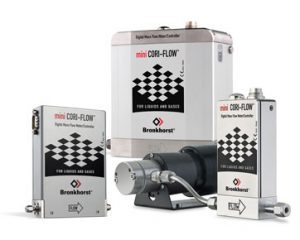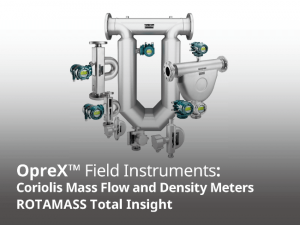Mass Flowmeters | Coriolis Flowmeters
A mass flow meter is an instrument that measures the flow of a gas or liquid in terms of mass per unit time, rather than just volume per unit time (as a standard volumetric flow meter does). Mass flow measurement is important in processes where you want to know exactly how much matter (not just volume) is flowing, as density can vary with temperature, pressure and composition.
- System Solutions
- Gas Analysis
- Liquid Analysis
- Flowmeters
- Pressure Gauges
- Level Gauges
- Temperature Gauges
- Laboratory Analysis
- Data Loggers
- Regulators
More information
Coriolis mass flow meter - How does it work?
-
Vibrating tubes
A Coriolis meter often consists of one or two thin tubes through which the liquid or gas flows. These tubes are set in a controlled vibration, usually by an oscillator. -
Coriolis force
When a medium flows through the vibrating tubes, a Coriolis force (the same effect that causes weather and ocean currents on Earth to rotate in different patterns). This force twists or bends the pipes slightly depending on the mass flow rate. -
Phase difference
By measuring the difference in phase (time shift) between different points on the vibrating tubes, the instrument can determine the magnitude of the Coriolis force. The greater the mass flow, the greater the twist or phase shift. -
Direct mass flow
From the measurement of this phase shift is calculated directly mass flow rate. At the same time, the meter can often also calculate the density by measuring the resonance frequency of the pipe (heavier liquid/gas affects the resonance differently than a lighter one).
Advantages
-
High accuracy for both mass flow and density.
-
Independent of temperature and pressure to a large extent (do not need to compensate for changes in density).
-
Multifunction: Provides both mass flow, density and temperature.
Disadvantages
-
Higher cost than simpler flowmeters.
-
Sensitive to vibrations in the environment, which sometimes requires some damping or robust installation.
Thermal (thermal dispersion) mass flow meter - How does it work?
-
Heated sensor
A thermal mass flow meter usually has one or two sensor elements (e.g. platinum sensors) that are heated to a known temperature. -
Cooling of the flow
When gas (or in some cases liquid) flows over the heated sensor, the sensor cools down. The cooling is proportional to the mass flow, as it is the mass of the medium that carries away the heat, not the volume. -
Temperature difference
Measuring how much current or power is required to keep the sensor at a constant temperature (or how much the temperature drops at constant power) gives a measure of mass flow. -
Calibration required
The measurement is based on heat transfer, so calibration is required for the specific medium (different gases have different thermal conductivity, heat capacity, etc.). For multi-component gas mixtures, more advanced calibration may be needed.
Advantages
-
Relatively simple mechanical design (no moving parts in the flow sensor itself).
-
Good for dry, clean gases in laboratory and process applications, for example.
-
Rapid response in case of rapid changes in flow.
Disadvantages
-
Sensitive to compositional changes of the gas (changing the gas mixture may affect the result).
-
May be sensitive to soiling (coatings or particles can alter the heat transfer of the sensor).
-
Less common for liquids (some specialised versions available).



